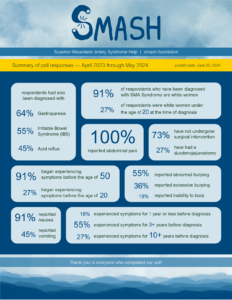For those newly diagnosed with SMA Syndrome

If you’re newly diagnosed with SMA Syndrome, congratulations! This diagnosis might be scary, and it might seem unfair. But the fact that you now know what’s been causing your pain is a good thing. See below for a helpful guide for navigating your new reality.
Learn about SMA Syndrome
Read through our what is superior mesenteric artery syndrome page so that you understand what’s going on in your body. As you’re reading, jot down any questions you have so that you can ask your doctor at your next appointment.
You’ve been diagnosed with SMA Syndrome, now reset your expectations
Life with a chronic illness can be difficult physically, mentally, spiritually, and socially. Don’t be too hard on yourself. Read up on spoon theory, a helpful technique for pacing yourself when things get hard.
SMA Syndrome causes pain, and it also prevents the body from absorbing critical nutrients. This nutrient deficiency impacts all of the systems in your body. You may experience brain fog and fatigue, if you’re not getting enough nutrients to fuel your brain and your cardiovascular system.
Think about how you want to share your SMA Syndrome diagnosis with the world
You may want to share your diagnosis with family, friends, and work colleagues, but it can be hard to describe to people who aren’t as close to it as you are. It’s likely that those around you won’t be able to empathize with you as much as you’d like.
Find a network of people who can relate to what you’re going through. The internet is a great place to connect with people all around the globe who are going through similar circumstances. The National Organization for Rare Disorders (NORD) provides excellent resources for patients and their families.
Read IG Living’s Telling it all: how to share the news of your diagnosis for more in-depth tips.
If you’re currently employed, learn your rights and benefits
Read through your employee handbook to understand what benefits you may be able to access, such as paid time off for sick leave, leaves of absence, and reduced work hours. Research available health care plans, Health Savings Accounts (HSAs), and Flexible Spending Accounts (FSAs).
If you live in the United States, you may be covered under the U.S. Department of Labor’s Family and Medical Leave (FMLA), which provides certain employees with up to 12 weeks of unpaid, job-protected leave per year.
The Harvard Business Review article When Someone on Your Team Has Chronic Pain shares some of the ways workplaces are expected to support their employees who are suffering from chronic illnesses such as SMA Syndrome.
Request your medical records
Go online or call to request your medical records from every doctor you’ve seen. You may have to pay for paper copies, but it’s likely that these records are online. When you receive these records, organize them and make copies. Bring one copy to your primary care physician, and file the other one away for your records.
As you undergo medical tests and procedures, the results are usually sent directly to your doctor. Tell the testing doctor or technician that you want to receive the results as well. Then store these with your other records.
Find a doctor who specializes in SMA Syndrome
You may need a doctor beyond the one who diagnosed you with SMA Syndrome.
Work with your primary care doctor or search online to find a gastrointestinal specialist. Make an appointment, and request a longer session so that you don’t feel rushed when you’re sharing your medical history with your doctor, and so that you can ask plenty of questions. When you arrive to the session, bring a notebook and pencil so that you can write down what the doctor tells you. Don’t be afraid to meet with a few different doctors until you find one that you really like.
You’ll still see your primary care physician for routine wellness checks and procedures, but it’s good to go ahead and get in the system of a specialist you like in case you need expert care quickly.
Check out our Find a Doctor page to search for a physician near you.
The United States National Institute of Health has more detailed guidance for How to Find a Disease Specialist.
Track your SMA Syndrome symptoms
Now that you’ve been diagnosed, it’s important to track your health from day to day. Start a notebook or online health tracker to note your symptoms on a regular basis. This will be helpful for your doctor if your condition deteriorates, and it can also help you see the impact of your diet and activities on your condition.
SMA Syndrome can cause additional problems in your body, such as malnutrition. If something doesn’t feel right, talk to your doctor.
Collect recipes for easy, delicious puréed food that will provide the nutrients needed for those diagnosed with SMA Syndrome
The Memorial Sloan Kettering Cancer Center provides a detailed eating guide for puréed and mechanical soft diets.
Check out our Free Resources page, which includes a puréed food shopping list. In addition, our Purée away Pinterest board houses a collection of delicious recipes and quick ready-made options.
Essential Purée is a great source for delicious puréed recipes for adults.
Be sure you’re getting all the nutrients you need
If you have ongoing inflammation in your duodenum, or you’ve had a duodenojejunostomy surgery, you should talk to your doctor about your body’s ability to absorb key fat-soluble nutrients (vitamins A, D, E, and K in particular). Your doctor can order a simple blood or urine test to determine the level of vitamins and minerals in your body.
If you have been diagnosed with SMA Syndrome, ask your doctor to test your body’s levels of these fat-soluble vitamins:
- Vitamin A deficiency can lead to vision problems.
- Vitamin D deficiency can lead to weakened muscles and bones.
- Vitamin E deficiency can lead to a reduction in red blood cells and neurological issues.
- Vitamin K deficiency can lead to bleeding and bruising and can weaken bones.
If you have low vitamin levels, there are many supplements you can take to address this, both over-the-counter and prescription.
Some key vitamins are only absorbed in the duodenum. These are generally fat-soluble, which means they need to be taken with fats in order for your body to absorb them. Many vitamins are sold as “liposomal,” which is designed to enhance the bioavailability and absorption of these fat-soluble vitamins. You can also take vitamins at the same time as a meal (add a little extra butter!), or with an oil like olive oil or hemp oil, which has many amino acids.
Many of these vitamins can also be taken in a liquid form, which SMA Syndrome patients often prefer and may require. Prescription medications can be liquified by a compounding pharmacy. For over-the-counter medications, a couple popular brands are Mary Ruth’s and Garden of Life, but you should talk with your doctor to determine which quantities and combinations are right for you.
Ask your doctor to check for allergies that can worsen inflammation
Eating foods that cause an allergic reaction can result in additional inflammation of the small intestine. Allergens don’t always cause an immediate reaction – inflammation can sometimes be delayed by several days. This makes it difficult for patients to determine which foods are causing issues. If you have been diagnosed with SMA Syndrome, consider asking your doctor to refer you to an allergy specialist, who can perform a patch test. This test will determine allergens that may cause inflammation in your body. Patients with SMA Syndrome can experience some relief by avoiding foods that contain allergens. Some food intolerance allergens include:
- Gluten is a protein found in wheat, barley, and rye. It is commonly added to foods for thickening and flavor. Often found in: bread, baked goods, pasta, cereal, crackers, beer, gravy, soup, battered (fried) items, and sauces
- Nickel is a metal that enters plants through the soils in which they are grown. Often found in: flour and grains, seeds, seafood, beans and legumes, some leafy vegetables, dried fruits, avocado, and chocolate.
Take our SMASH poll to improve SMA Syndrome research
Filling out this anonymous poll will provide our community with critical information about the management of this condition. Because SMA Syndrome is so rare, there is much we don’t know about it. Your insights into the management of this condition can be very helpful for others who are struggling through trial-and-error.
Click here to complete the poll, which should take about 10-20 minutes.
Request a free SMASH Care Package
The package contains information about your diagnosis, a next steps guide, and food items that others with SMA Syndrome have found useful.
Click here to request a package
Take part in a clinical trial
Visit the U.S. National Library of Medicine Clinical trials site to sign up for a clinical trial. The results of trials increase understanding and improve the treatment of this rare condition.
